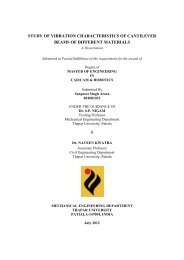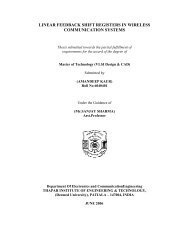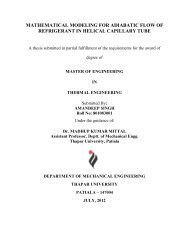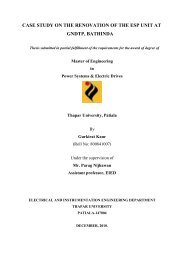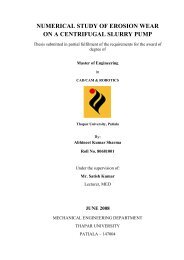from indigenous fermented foods and human gut ... - Thapar University
from indigenous fermented foods and human gut ... - Thapar University
from indigenous fermented foods and human gut ... - Thapar University
You also want an ePaper? Increase the reach of your titles
YUMPU automatically turns print PDFs into web optimized ePapers that Google loves.
6<br />
Chapter I: Introduction<br />
food-borne illness in outbreaks during years 1975-2006 (Niskanen et al., 2007). Clearly, food<br />
<strong>and</strong> water safety need to be improved.<br />
Microbes have an extraordinary array of defense systems. These include classical<br />
antibiotics, metabolic by-products such as lactic acid, numerous types of protein exotoxins,<br />
<strong>and</strong> antimicrobial peptides such as bacteriocins. The most promising antimicrobial peptides<br />
are those produced by LAB. Most LAB bacteriocins are non-toxic to eukaryotic cells <strong>and</strong> are<br />
generally recognized as safe substances, active in the nanomolar range (Cotter et al., 2005;<br />
Peschel <strong>and</strong> Sahl, 2006). LAB antimicrobial peptides typically exhibit antibacterial activity<br />
against food-borne pathogens, as well as spoilage bacteria. Therefore, they have attracted the<br />
greatest attention as tools for food biopreservation (Collins et al. 1998; O’Sullivan et al.,<br />
2002; Reid et al., 2003). They either show bacteriostatic or bactericidal activity against<br />
targeted pathogens. Probiotics are now widely available commercially <strong>and</strong> marketed through<br />
food products such as yoghurt, <strong>fermented</strong> milks, <strong>fermented</strong> juices <strong>and</strong> freeze dried<br />
supplements. As commercially available probiotic strains are being produced <strong>and</strong> marketed<br />
for <strong>human</strong> consumption on a large scale, it is important to identify them at species <strong>and</strong> strain<br />
level.<br />
In past 10 years, there has been an increase in the consumption of probiotics <strong>and</strong><br />
functional <strong>foods</strong> in Western diets (O’sullivan, 1996). Probiotic bacteria are able to suppress<br />
potentially pathogenic microorganism in the gastrointestinal tract <strong>and</strong> enhance the population<br />
of beneficial microorganisms (Yaeshima et al., 1997). The health benefits derived by the<br />
consumption of <strong>foods</strong> containing probiotic bacteria are well documented <strong>and</strong> more than 90<br />
probiotic products are available worldwide. To provide health benefits, the suggested<br />
concentration for probiotic bacteria is 10 6 CFU/g of a product (Shah, 2000). However, studies<br />
have shown low viability of probiotics in market preparations (Shah et al., 1995). A number





